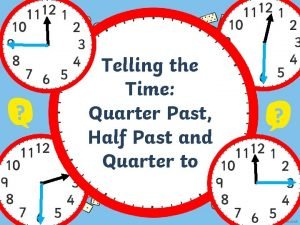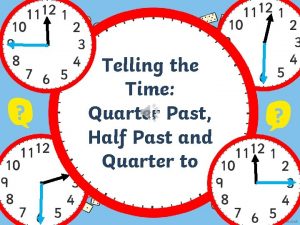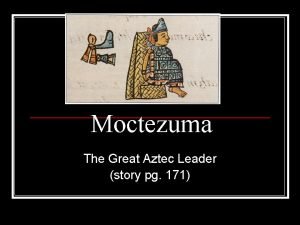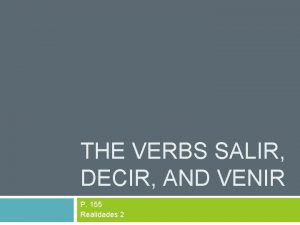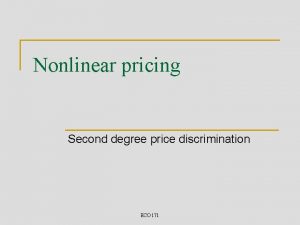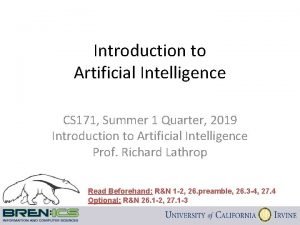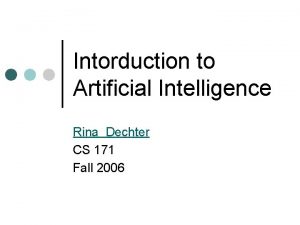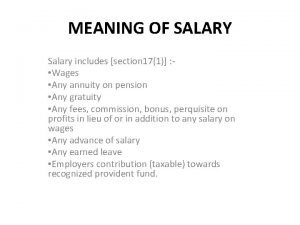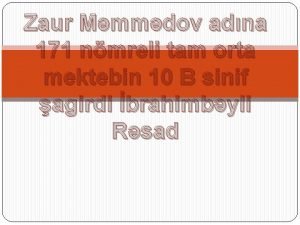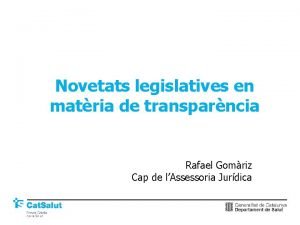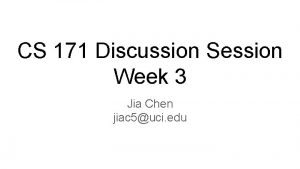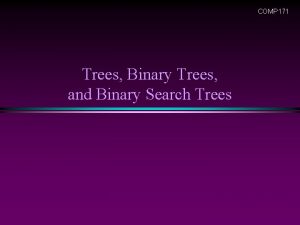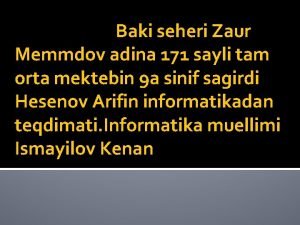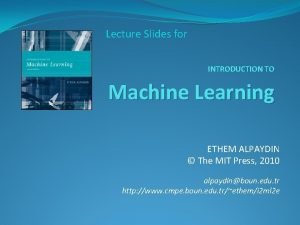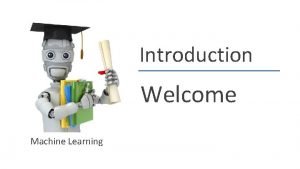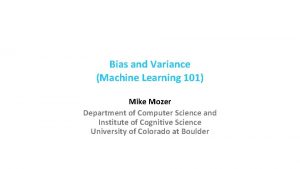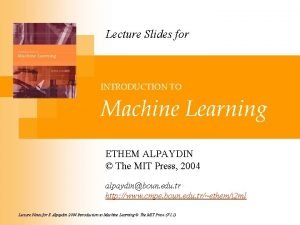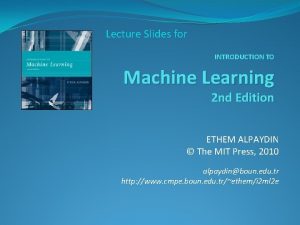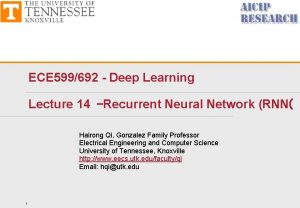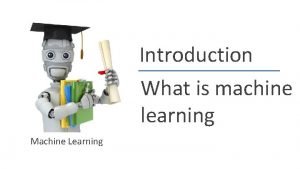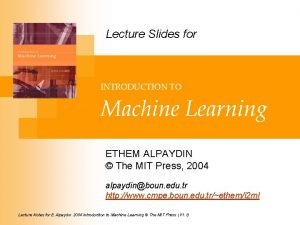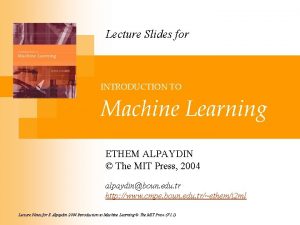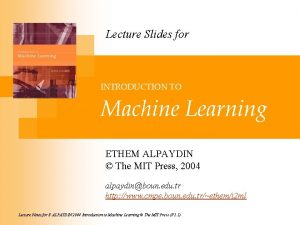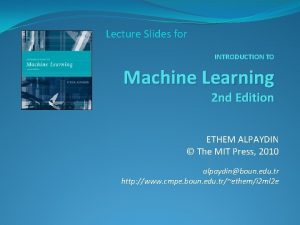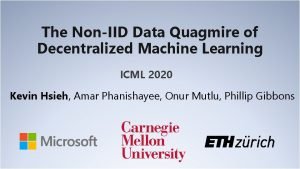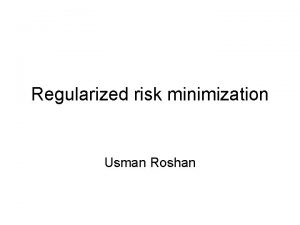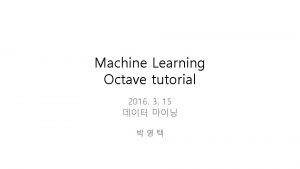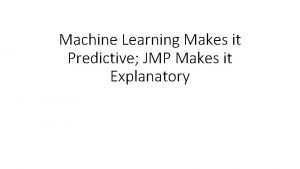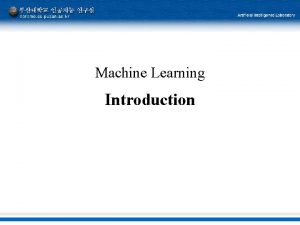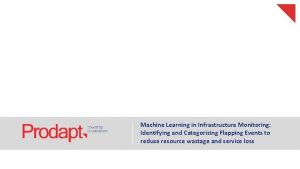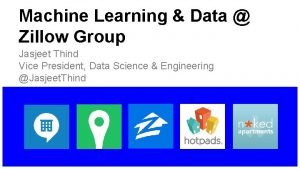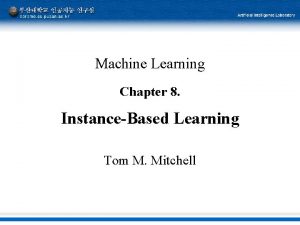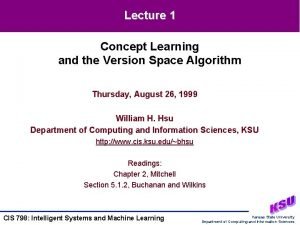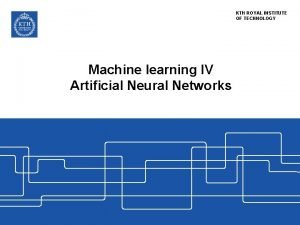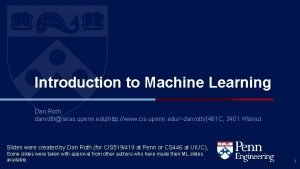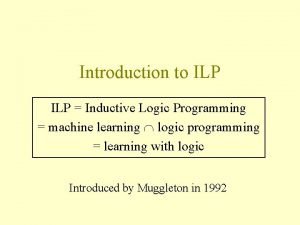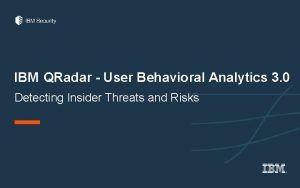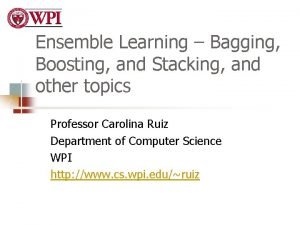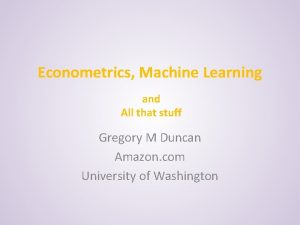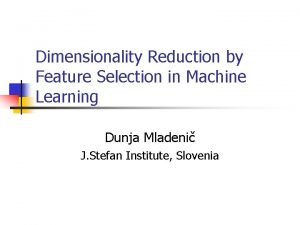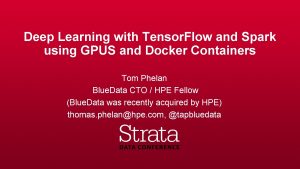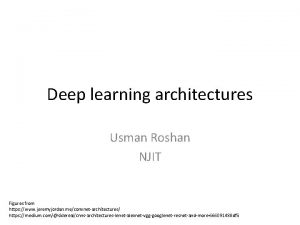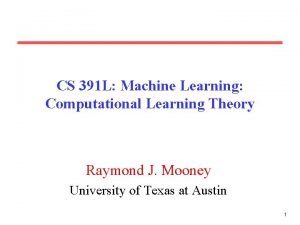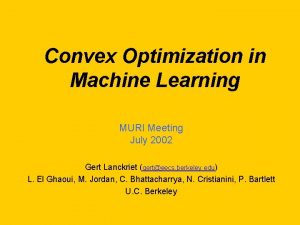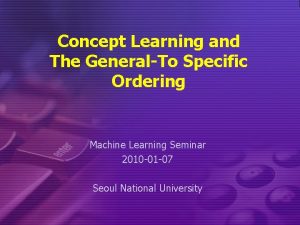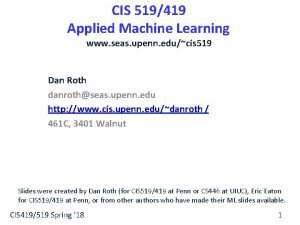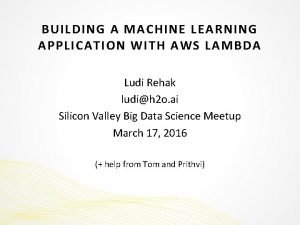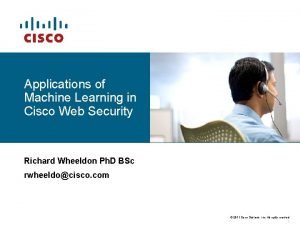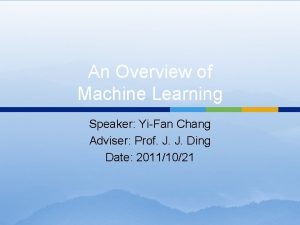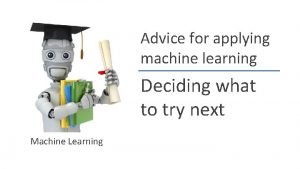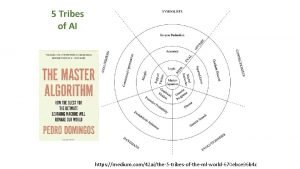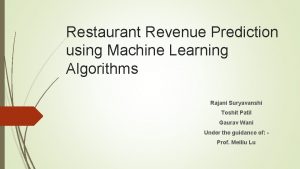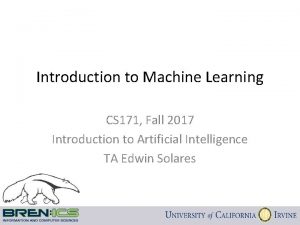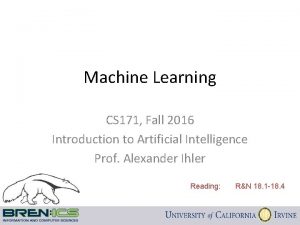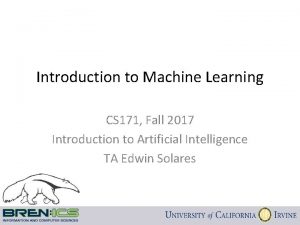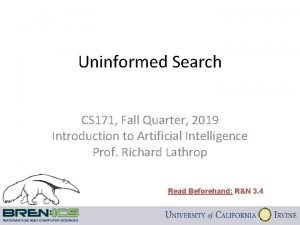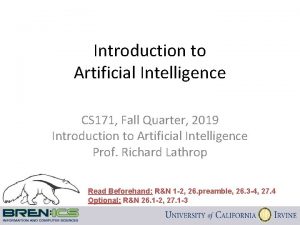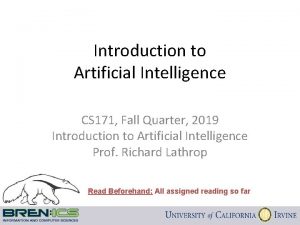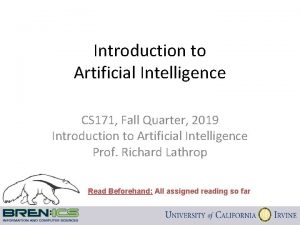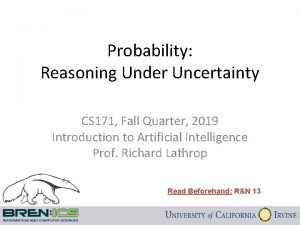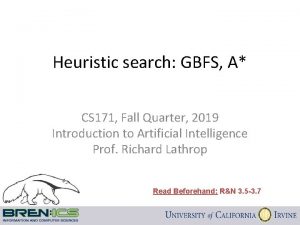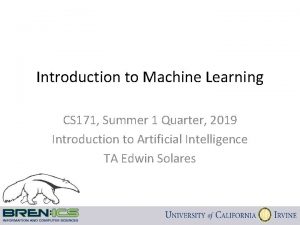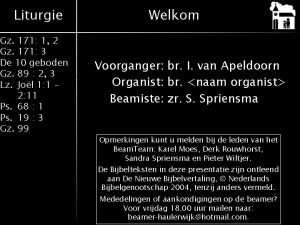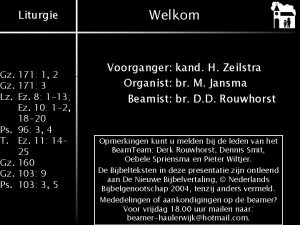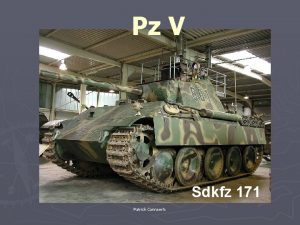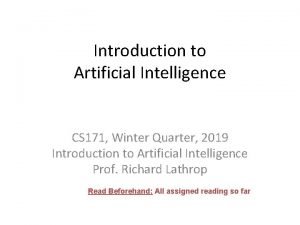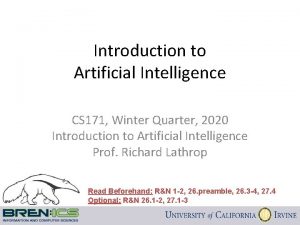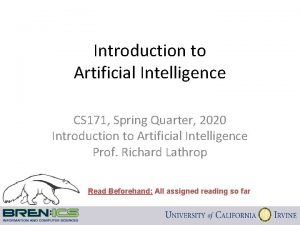Introduction to Machine Learning CS 171 Fall Quarter





































![Empirical Error Functions • E(h) = x distance[h(x, ) , f(x)] Sum is over Empirical Error Functions • E(h) = x distance[h(x, ) , f(x)] Sum is over](https://slidetodoc.com/presentation_image_h2/28bda0a294c8e31288b28c52912afdde/image-38.jpg)








































![Entropy and Information • Entropy H(X) = E[ log 1/p(X) ] = å x Entropy and Information • Entropy H(X) = E[ log 1/p(X) ] = å x](https://slidetodoc.com/presentation_image_h2/28bda0a294c8e31288b28c52912afdde/image-79.jpg)


- Slides: 81

Introduction to Machine Learning CS 171, Fall Quarter, 2019 Introduction to Artificial Intelligence TA Edwin Solares

p 53 and Human Cancers • p 53 is a central tumor suppressor protein Thanks to Richard Lathrop “The guardian of the genome” • Cancer Mutants: About 50% of all human cancers have p 53 mutations. • Rescue Mutants: Several second-site mutations restore functionality to some p 53 cancer mutants in vivo. p 53 core domain bound to DNA Image Generated with UCSF Chimera Cho, Y. , Gorina, S. , Jeffrey, P. D. , Pavletich, N. P. Crystal structure of a p 53 tumor suppressor-DNA complex: understanding tumorigenic mutations. Science v 265 pp. 346 -355 , 1994

Active Learning for Biological Discovery Thanks to Richard Lathrop Find Cancer Rescue Mutants Knowledge Theory Experiment

Computational Active Learning Pick the Best (= Most Informative) Unknown Examples to Label Unknown Known Example 1 Example 2 Example 3 … Example N+1 Train the Classifier Example N+2 Classifier Example N+3 Choose Example(s) to Label Example N+4 … Example M Training Set Add New Example(s) To Training Set

Visualization of Selected Regions • Positive Region: Predicted Active 96 -105 (Green) Thanks to Richard Lathrop • Negative Region: Predicted Inactive 223 -232 (Red) • Expert Region: Predicted Active 114 -123 (Blue) Danziger, et al. (2009)

Novel Single-a. a. Cancer Rescue Mutants Thanks to Richard Lathrop MIP Positive (96 -105) MIP Negative (223 -232) Expert (114 -123) # Strong Rescue 8 0 (p < 0. 008) 6 (not significant) # Weak Rescue 3 2 (not significant) 7 (not significant) Total # Rescue 11 2 (p < 0. 022) 13 (not significant) p-Values are two-tailed, comparing Positive to Negative and Expert regions. Danziger, et al. (2009) No significant differences between the MIP Positive and Expert regions. Both were statistically significantly better than the MIP Negative region. The Positive region rescued for the first time the cancer mutant P 152 L. No previous single-a. a. rescue mutants in any region.

Complete architectures for intelligence? • Search? – Solve the problem of what to do. • Logic and inference? – Reason about what to do. – Encoded knowledge/”expert” systems? • Know what to do. • Learning? – Learn what to do. • Modern view: It’s complex & multi-faceted.

Automated Learning • Why learn? – Key to intelligence – Take real data get feedback improve performance reiterate – USC Autonomous Flying Vehicle Project • Types of learning – Supervised learning: learn mapping: attributes “target” – Classification: learn discreet target variable (e. g. , spam email) – Regression: learn real valued target variable (e. g. , stock market) – Unsupervised learning: no target variable; “understand” hidden data structure – Clustering: grouping data into K groups (e. g. K-means) – Latent space embedding: learn simple representation of the data (e. g. PCA, SVD) – Other types of learning • Reinforcement learning: e. g. , game-playing agent • Learning to rank, e. g. , document ranking in Web search • And many others….

Unsupervised Learning Finding hidden structure in unlabeled data

Unsupervised Learning Principal Component Analysis PCA T=XW X is a m-by-n matrix, where n columns represent attributes and m rows represent samples W is a m-by-m matrix whose columns are the eigenvectors of XTX T is eigenvalue decomposition of a data covariance matrix • Explains variance in the data via principle components

Domestication in Crops Principle Component Analysis (PCA) in Biology Maize Trtikova et al, 2017

Domestication in Crops Rice Chung et al, 2015

Domestication in Crops Principle Component Analysis (PCA) + K-means Clustering Rice Kanapeckas et al, 2016 Citrus Wu et al, 2018

Clustering Unsupervised Learning

Thanks to Padhraic Smyth Application to Extra-Tropical Cyclones Gaffney et al, Climate Dynamics, 2007

Thanks to Padhraic Smyth Original Data Iceland Cluster Greenland Cluster Horizontal Cluster

Thanks to Padhraic Smyth Cluster Shapes for Pacific Typhoon Tracks Camargo et al, J. Climate, 2007

Thanks to Padhraic Smyth TROPICAL CYCLONES Western North Pacific © Padhraic Smyth, UC Irvine: DS 06 Camargo et al, J. Climate, 2007 19

Thanks to Padhraic Smyth An ICS Undergraduate Success Story “The key student involved in this work started out as an ICS undergrad. Scott Gaffney took ICS 171 and 175, got interested in AI, started to work in my group, decided to stay in ICS for his Ph. D, did a terrific job in writing a thesis on curve-clustering and working with collaborators in climate science to apply it to important scientific problems, and is now one of the leaders of Yahoo! Labs reporting directly to the CEO there, http: //labs. yahoo. com/author/gaffney/. Scott grew up locally in Orange County and is someone I like to point as a great success story for ICS. ” --- From Padhraic Smyth

Supervised Learning Inference made by learning from labeled training data

Computer Vision Classification Courtesy of Nvidia Website

Computer Vision Classification Courtesy of Nvidia Website

Computer Vision PEAS = Performance Measure, Environment, Actuators, and Sensors Actuators Sensors Courtesy of Nvidia Website Environment Performance Measure

Deep Learning Example Neural Net x 1*w 1 + b 1 x 2*w 2 + b 2 X y Maize Trtikova et al, 2017 Courtesy of Nvidia Website

Neurons 1 st Generation Neuron (Mc. Culloch-Pitts) 2 nd Generation Neuron 3 rd Generation Neuron (Spiking Neurons) Hodgkin-Huxley Model Izhikevish Model Leakage Integrate-and-Fire Model https: //www. slideshare. net/hitechpro/introduction-to-spiking-neural-networksfrom-acomputational-neuroscience-perspective/30

Deep Learning Example of Best Price using Deep Neural Net (Deep Learning) HL 1 HL 4 HL 2 HL 3 Courtesy of Nvidia Website HL 5

Computer Vision Increasing computational power Courtesy of Nvidia Website

Computer Vision PEAS = Performance Measure, Environment, Actuators, and Sensors Courtesy of Nvidia Website Reward function Utility gradient

Minimization of Cost Function Gradient Decent Courtesy of Nvidia Website

Minimization of Cost Function Gradient Decent Local Minima Global Minima Entertaining and informative way to learn about Neural Nets and Deep Learning https: //www. youtube. com/watch? v=p 69 khggr 1 Jo

Deep Learning in Physics: Searching for Exotic Particles Thanks to Pierre Baldi

Thanks to Pierre Baldi

Thanks to Pierre Baldi Daniel Whiteson Peter Sadowski

Higgs Boson Detection Thanks to Pierre Baldi BDT= Boosted Decision Trees in TMVA package Deep network improves AUC by 8% Nature Communications, July 2014

Supervised Learning Definitions and Properties

Terminology • Attributes – Also known as features, variables, independent variables, covariates • Target Variable – Also known as goal predicate, dependent variable, f(x), y … • Classification – Also known as discrimination, supervised classification, … • Error function – Objective function, loss function, …

Supervised learning
![Empirical Error Functions Eh x distancehx fx Sum is over Empirical Error Functions • E(h) = x distance[h(x, ) , f(x)] Sum is over](https://slidetodoc.com/presentation_image_h2/28bda0a294c8e31288b28c52912afdde/image-38.jpg)
Empirical Error Functions • E(h) = x distance[h(x, ) , f(x)] Sum is over all training pairs in the training data D Examples: distance = squared error if h and f are real-valued (regression) distance = delta-function if h and f are categorical (classification) In learning, we get to choose 1. what class of functions h(. . ) that we want to learn – potentially a huge space! (“hypothesis space”) 2. what error function/distance to use - should be chosen to reflect real “loss” in problem - but often chosen for mathematical/algorithmic convenience

Inductive Learning as Optimization or Search • Empirical error function: E(h) = • x distance[h(x, ) , f(x)] Empirical learning = finding h(x), or h(x; ) that minimizes E(h) – In simple problems there may be a closed form solution • E. g. , “normal equations” when h is a linear function of x, E = squared error – If E(h) is differentiable continuous optimization problem using gradient descent, etc • E. g. , multi-layer neural networks – If E(h) is non-differentiable (e. g. , classification systematic search problem through the space of functions h • E. g. , decision tree classifiers • Once we decide on what the functional form of h is, and what the error function E is, then machine learning typically reduces to a large search or optimization problem • Additional aspect: we really want to learn a function h that will generalize well to new data, not just memorize training data – will return to this later

Simple illustrative learning problem Problem: decide whether to wait for a table at a restaurant, based on the following attributes: 1. Alternate: is there an alternative restaurant nearby? 2. Bar: is there a comfortable bar area to wait in? 3. Fri/Sat: is today Friday or Saturday? 4. Hungry: are we hungry? 5. Patrons: number of people in the restaurant (None, Some, Full) 6. Price: price range ($, $$$) 7. Raining: is it raining outside? 8. Reservation: have we made a reservation? 9. Type: kind of restaurant (French, Italian, Thai, Burger) 10. Wait. Estimate: estimated waiting time (0 -10, 10 -30, 30 -60, >60) Is it a weekend? Hungry? Busy? Cost? Wait time? Etc…

Example Training Data • If all attributes were binary, h(. . ) could be any arbitrary Boolean function • Natural error function E(h) to use is classification error, i. e. , how many incorrect predictions does a hypothesis h make • Note an implicit assumption: – – For any set of attribute values there is a unique target value This in effect assumes a “no-noise” mapping from inputs to targets • This is often not true in practice (e. g. , in medicine).

Supervised Learning Decision Trees

Learning Boolean Functions William of Ockham c. 1288 -1347

Decision Tree Representations •

Decision Tree Representations

Decision Tree Learning • Find the smallest decision tree consistent with the n examples – Not optimal – n<d • Greedy heuristic search used in practice: – – • Select root node that is “best” in some sense Partition data into 2 subsets, depending on root attribute value Recursively grow subtrees Different termination criteria • For noiseless data, if all examples at a node have the same label then declare it a leaf and backup • For noisy data it might not be possible to find a “pure” leaf using the given attributes – a simple approach is to have a depth-bound on the tree (or go to max depth) and use majority vote We have talked about binary variables up until now, but we can trivially extend to multi-valued variables

Pseudocode for Decision tree learning

Decision Tree Learning Authors Created

Choosing an attribute • Idea: a good attribute splits the examples into subsets that are (ideally) "all positive" or "all negative" • Patrons? is a better choice – How can we quantify this? – One approach would be to use the classification error E directly (greedily) • Empirically it is found that this works poorly – Much better is to use information gain (next slides)

Entropy and Information • “Entropy” is a measure of randomness • In chemistry: https: //www. youtube. com/watch? v=Zs. Y 4 Wc. QOrfk

Entropy with only 2 outcomes In binary case (2 outcomes) 1 0 0. 5 For multiple outcomes we have 1

Information Gain • H(p) = entropy of class distribution at a particular node • H(p | A) = conditional entropy • Weighted average entropy of conditional class distribution • Partitioned the data according to the values in A • The sum of each partition given the group/class • Gain(A) = H(p) – H(p | A) • Simple rule in decision tree learning – At each internal node, split on the node with the largest information gain (or equivalently, with smallest H(p|A)) • Note that by definition, conditional entropy can’t be greater than the entropy

Entropy Example 10 Squares 11 Circles 1 Square 9 Circles 9 Square 2 Circles Weighted average

Root Node Example For the training set, 6 positives, 6 negatives, H(6/12, 6/12) = 1 bit positive (p) negative (1 -p) Consider the attributes Patrons and Type: Conclude: Patrons has the highest IG of all attributes and so is chosen by the learning algorithm as the root Information gain is then repeatedly applied at internal nodes until all leaves contain only examples from one class or the other

Decision Tree Learned Authors Created Learned

Assessing Performance Training data performance is typically optimistic e. g. , error rate on training data Reasons? - classifier may not have enough data to fully learn the concept (but on training data we don’t know this) - for noisy data, the classifier may overfit the training data In practice we want to assess performance “out of sample subsets” how well will the classifier do on new unseen data? This is the true test of what we have learned (like we take exams) With large data sets we can partition our data into 2 subsets, train and test - build a model on the training data - assess performance on the test data

Training and Validation Data Full Data Set Training Data Validation Data Idea: train each model on the “training data” and then test each model’s accuracy on the validation data

Overfitting and Underfitting Y X

A Complex Model Y = high-order polynomial in X Y X

A Much Simpler Model Y = a X + b + noise Y X

Example 2

Example 2

Example 2

Example 2

Example 2

How Overfitting affects Prediction Predictive Error on Training Data Model Complexity

How Overfitting affects Prediction Predictive Error on Test Data Error on Training Data Model Complexity

How Overfitting affects Prediction Complex Models Underfitting Overfitting Predictive Error on Test Data Error on Training Data Model Complexity Ideal Range for Model Complexity Simple Models

The k-fold Cross-Validation Method • Why stop at a 90/10 “split” of the data? – In principle we could do this multiple times • “k-fold Cross-Validation” (e. g. , k=10) – randomly partition our full data set into k disjoint subsets (each roughly of size n/k, n = total number of training data points) • for i = 1: k (where k = 10) – train on 90% of the ith data subset – Accuracy[i] = accuracy on 10% of the ith data subset • end • Cross-Validation-Accuracy = 1/k i Accuracy[i] – choose the method with the highest cross-validation accuracy – common values for k are 5 and 10 – Can also do “leave-one-out” where k = n

Disjoint Validation Data Sets for k = 5 Validation Data (aka Test Data) Full Data Set 1 st partition Training Data

Disjoint Validation Data Sets for k = 5 Validation Data (aka Test Data) Full Data Set 1 st partition 2 nd partition Training Data

Disjoint Validation Data Sets for k = 5 Validation Data (aka Test Data) Full Data Set Validation Data 1 st partition 2 nd partition Training Data 3 rd partition 4 th partition 5 th partition

More on Cross-Validation • Notes – cross-validation generates an approximate estimate of how well the learned model will do on “unseen” data – by averaging over different partitions it is more robust than just a single train/validate partition of the data – “k-fold” cross-validation is a generalization • partition data into disjoint validation subsets of size n/k • train, validate, and average over the v partitions • e. g. , k=10 is commonly used – k-fold cross-validation is approximately k times computationally more expensive than just fitting a model to all of the data

You will be expected to know Understand Attributes, Error function, Classification, Regression, Hypothesis (Predictor function) What is Supervised and Unsupervised Learning? Decision Tree Algorithm Entropy Information Gain Tradeoff between train and test with model complexity Cross validation

Extra Slides

Summary • Inductive learning – Error function, class of hypothesis/models {h} – Want to minimize E on our training data – Example: decision tree learning • Generalization – Training data error is over-optimistic – We want to see performance on test data – Cross-validation is a useful practical approach • Learning to recognize faces – Viola-Jones algorithm: state-of-the-art face detector, entirely learned from data, using boosting+decision-stumps

Importance of representation Properties of a good representation: • Reveals important features • Hides irrelevant detail • Exposes useful constraints • Makes frequent operations easy-to-do • Supports local inferences from local features • Called the “soda straw” principle or “locality” principle • Inference from features “through a soda straw” • Rapidly or efficiently computable • It’s nice to be fast

Reveals important features / Hides irrelevant detail • “You can’t learn what you can’t represent. ” --- G. Sussman • In search: A man is traveling to market with a fox, a goose, and a bag of oats. He comes to a river. The only way across the river is a boat that can hold the man and exactly one of the fox, goose or bag of oats. The fox will eat the goose if left alone with it, and the goose will eat the oats if left alone with it. • A good representation makes this problem easy: 1110 0010 1111 0001 0101
![Entropy and Information Entropy HX E log 1pX å x Entropy and Information • Entropy H(X) = E[ log 1/p(X) ] = å x](https://slidetodoc.com/presentation_image_h2/28bda0a294c8e31288b28c52912afdde/image-79.jpg)
Entropy and Information • Entropy H(X) = E[ log 1/p(X) ] = å x X p(x) log 1/p(x) = −å x X p(x) log p(x) – Log base two, units of entropy are “bits” – If only two outcomes: H = - p log(p) - (1 -p) log(1 -p) • Examples: H(x) =. 25 log 4 +. 25 log 4 = 2 bits Max entropy for 4 outcomes H(x) =. 75 log 4/3 +. 25 log 4 = 0. 8133 bits H(x) = 1 log 1 = 0 bits Min entropy

Entropy and Information • “Entropy” is a measure of randomness – How long a message does it take to communicate a result to you? – Depends on the probability of the outcomes; more predictable = shorter message • Communicating fair coin tosses – Output: H H T T T H H T … – Sequence takes n bits – each outcome totally unpredictable • Communicating my daily lottery results – Output: 0 0 0 … Lost: 0 – Most likely to take one bit – I lost every day. Won 1: 1(when)0 – Small chance I’ll have to send more bits (won & when) Won 2: 1(when)0 • More predictable takes less length to communicate because it’s less random – Use a few bits for the most likely outcome, more for less likely ones

Example of Test Performance Restaurant problem - simulate 100 data sets of different sizes - train on this data, and assess performance on an independent test set - learning curve = plotting accuracy as a function of training set size - typical “diminishing returns” effect (some nice theory to explain this)
 Quarter 3 time
Quarter 3 time Quarter 3 time
Quarter 3 time Pg 171
Pg 171 29052007
29052007 What do salir decir and venir have in common
What do salir decir and venir have in common 171
171 Ai 171
Ai 171 Ai 171
Ai 171 Tax allowance meaning
Tax allowance meaning Informasiya prosesleri
Informasiya prosesleri 171 nomreli mekteb
171 nomreli mekteb Decret 171/2015
Decret 171/2015 What is hazardous material
What is hazardous material Cs 171 uci
Cs 171 uci 171 in binary
171 in binary 171 nomreli mekteb
171 nomreli mekteb 171 nomreli mekteb
171 nomreli mekteb Concept learning task in machine learning
Concept learning task in machine learning Analytical learning in machine learning
Analytical learning in machine learning Pac learning model in machine learning
Pac learning model in machine learning Pac learning model in machine learning
Pac learning model in machine learning Inductive and analytical learning in machine learning
Inductive and analytical learning in machine learning Inductive learning approach
Inductive learning approach Instance based learning in machine learning
Instance based learning in machine learning Inductive learning machine learning
Inductive learning machine learning First order rule learning in machine learning
First order rule learning in machine learning Eager learning examples
Eager learning examples Cmu machine learning
Cmu machine learning Ethem alpaydin
Ethem alpaydin Andrew ng introduction to machine learning
Andrew ng introduction to machine learning Andrew ng intro machine learning
Andrew ng intro machine learning Mike mozer
Mike mozer Machine learning ethem
Machine learning ethem Machine learning introduction slides
Machine learning introduction slides Introduction to machine learning slides
Introduction to machine learning slides Introduction to machine learning and data mining
Introduction to machine learning and data mining A friendly introduction to machine learning
A friendly introduction to machine learning Machine learning definition andrew ng
Machine learning definition andrew ng Introduction to machine learning ethem alpaydin
Introduction to machine learning ethem alpaydin Machine learning ethem alpaydin
Machine learning ethem alpaydin Introduction to machine learning ethem
Introduction to machine learning ethem Introduction to machine learning slides
Introduction to machine learning slides Cuadro comparativo de e-learning
Cuadro comparativo de e-learning Finite state machine vending machine example
Finite state machine vending machine example Mealy or moore machine
Mealy or moore machine Moore machine to mealy machine
Moore machine to mealy machine Ma=fr/fe
Ma=fr/fe Bsp classification
Bsp classification Regularized risk minimization
Regularized risk minimization Sql server predictive analytics
Sql server predictive analytics Azure machine learning studio logo
Azure machine learning studio logo Octave machine learning tutorial
Octave machine learning tutorial Jmp neural network
Jmp neural network Machine learning tom mitchell
Machine learning tom mitchell Machine learning in infrastructure monitoring
Machine learning in infrastructure monitoring Machine learning actuary
Machine learning actuary Zillow machine learning
Zillow machine learning Tom mitchell machine learning solutions chapter 3
Tom mitchell machine learning solutions chapter 3 Hypothesis space in machine learning
Hypothesis space in machine learning Kth machine learning
Kth machine learning Hypothesis space in machine learning
Hypothesis space in machine learning Ilp machine learning
Ilp machine learning Ibm qradar uba
Ibm qradar uba Machine learning xkcd
Machine learning xkcd Demographic parity
Demographic parity Stacking bagging boosting
Stacking bagging boosting Machine learning econometrics
Machine learning econometrics Dimensionality reduction in machine learning
Dimensionality reduction in machine learning What is tensor in machine learning
What is tensor in machine learning Njit machine learning
Njit machine learning Synapse vs databricks
Synapse vs databricks Hypothesis space in machine learning
Hypothesis space in machine learning Convex optimization in machine learning javatpoint
Convex optimization in machine learning javatpoint Concept learning and the general-to-specific ordering
Concept learning and the general-to-specific ordering Cis 519
Cis 519 Aws lambda machine learning
Aws lambda machine learning Youtube.com
Youtube.com Cisco machine learning security
Cisco machine learning security Ai yi fan
Ai yi fan Advice for applying machine learning
Advice for applying machine learning Machine learning tribes
Machine learning tribes Revenue prediction machine learning
Revenue prediction machine learning
